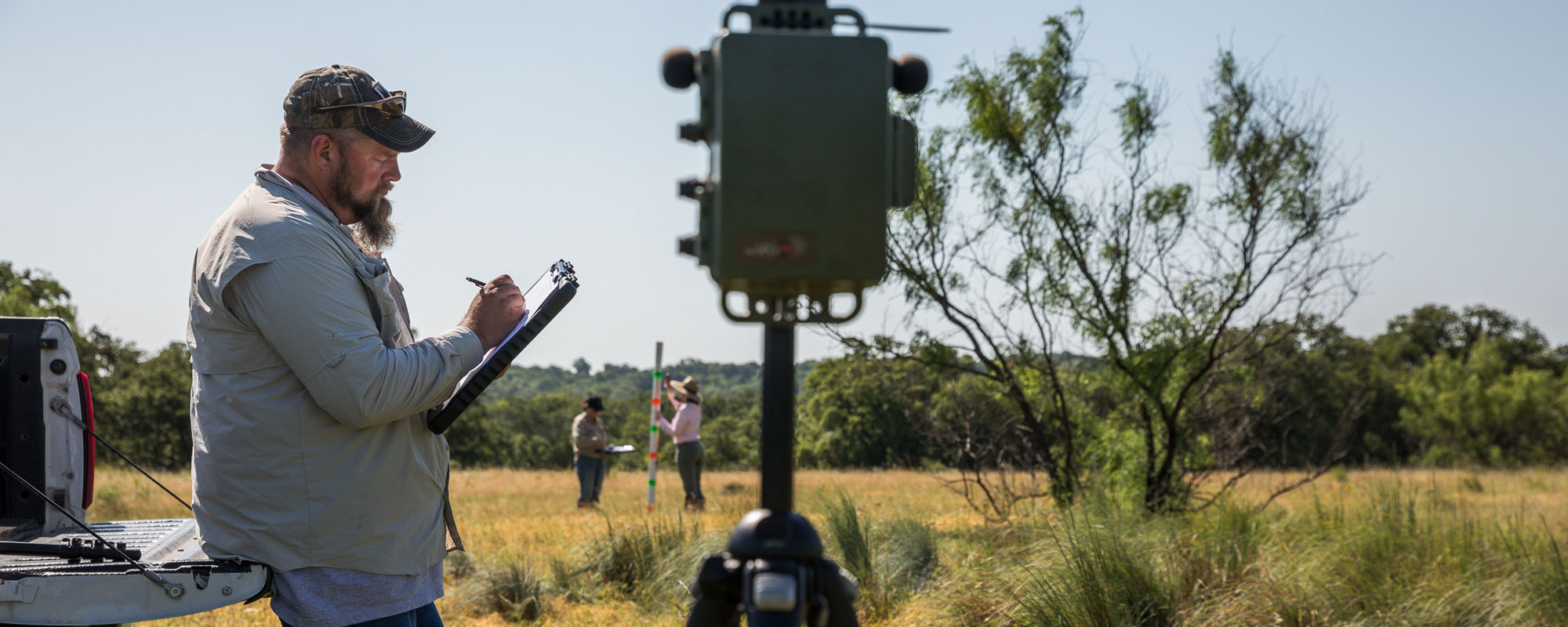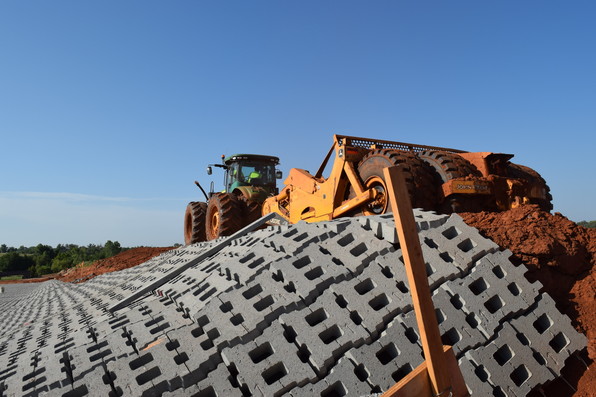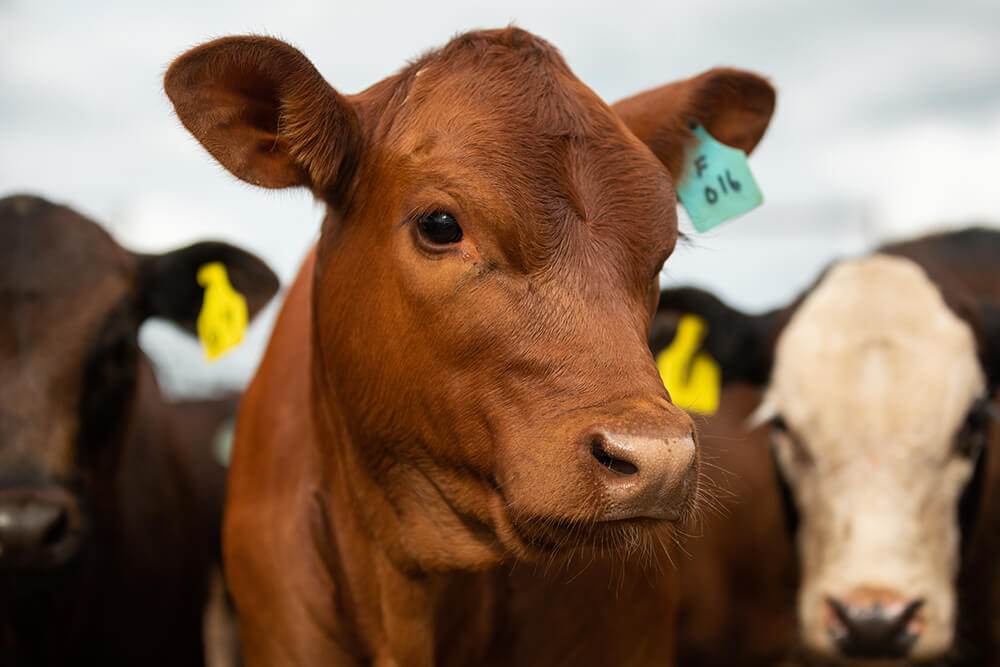Outdoors
Why Natural History Collections and Surveys Matter Today

By Mike Proctor
Senior Research Associate 1
A little more than 100 years ago, G.W. Stevens traveled across Oklahoma collecting plant specimens as the director of the Oklahoma State Botanical Survey. A portion of his first collecting trip brought him through Love and Carter counties, where several of the ranches operated by Noble Research Institute are located, ranches where I’ve spent much of the last nine years involved in various research projects.
Stevens’ field survey was the first major undertaking to identify what plants occurred in Oklahoma. Up until that point and for the next 50 years or so, the study of natural history mostly revolved around two questions: what and where. In other words, finding out what species were present and where they occurred. The only way to answer those questions was to go out and collect specimens which then were dried, mounted and deposited in herbariums, usually at universities. While people could come along and make maps or study the anatomy of all the specimens of a particular species, nothing really exciting happened in those collections.
As new technologies were developed and improved in the 1980s and ’90s, the attention shifted to looking at how species and groups were related to one another based on DNA and pollen analysis. This was pretty attractive to folks because it all took place under air conditioning and didn’t involve chiggers and ticks. Tissue samples for a study could easily be extracted from preserved herbarium specimens. Natural history studies dropped off dramatically and are continuing to decline.
There are a lot of questions out there today that didn’t exist when G.W. Stevens and other early collectors were stumbling around through the prairies and woods of Oklahoma. Natural history collections and surveys can contribute a great deal to the answers.
VEGETATION REFLECTS ECOSYSTEM HEALTH
From historical collections and newer samples collected in particular habitats, we can begin to develop a concept of ecosystem health. How many native species are present versus non-natives? How closely do the species present today represent those documented for the site in the past? How have environmental changes affected native vegetation? How have land use practices influenced native vegetation? What can be inferred from the current vegetation about historical land use?
If we detect a difference — some species are absent that were present and new species have appeared — we can ask: What about this site has changed? How rapidly are changes taking place? Can we implement management practices to reverse the changes? Rarely do species invade an intact community. There is usually some disturbance that has taken place that sets the stage. Often the culprit is overgrazing, but it also may be something like a lack of fire. For example, eastern redcedar takes advantage of both situations and causes havoc by invading grassland plant communities.
A great deal of information about the status of vertebrate and invertebrate species can be inferred by the status of the plant communities present. In most cases, the plant community is the habitat for those species. If it’s gone, they’re gone.
During field work in the heavily forested Big Thicket in southeast Texas, I occasionally came across single pitcher plants under closed-canopy pine forests. If they’re only supposed to grow in pine savannas, why were they growing in the middle of the forest? Fires had been suppressed for so long that the pines had taken over the original savannas, which were the habitat for the pitcher plants. I was finding relict populations. Collections data can let us know where such habitats once occurred and where they might occur again, if properly managed.
Collecting Provides Insight Into Invasive and Endangered Species When dealing with invasive species, other questions arise. Have those species always been around, or are they introduced? When did they first turn up? If they have always been around, why are they causing problems now? What has changed? How fast is the change occurring? Collections data can help answer those questions as well.
Natural history collections may also provide insight into endangered species that are particular about where they live. Data on specimen labels about geology and soils can be put into a GIS system and analyzed to locate other potential sites where those species might be found or could be reintroduced. It is also possible that what we thought was an endangered species based on museum collections isn’t nearly as endangered once someone starts to focus on collecting them. Many organisms are easy to overlook and just are seldom collected.
COLLECTING HELPS ANSWER BIODIVERSITY QUESTIONS
How many species occur on a site? Do some appear only during or after really dry periods, or really wet ones? Several native forbs dramatically increase in abundance after fires. It’s not that they are suddenly invading, but it’s how that plant community is responding to fire. After every fire, those species behave in that fashion. Two years after the fire, the forbs will once more be minor components of that community. Some of the species occurring on a site don’t show up every year, or even every decade. Seeds remain viable in the soil for extended periods of time and may germinate only when conditions are just right. This may occur only when the overhead canopy has been removed, such as in the case of a fire or after a severe drought.
Collecting in an area, even over an entire season, still doesn’t capture all of the biodiversity that is likely to be present there. I’m specifically referring to plants here, but I think that trend holds true for whatever group of organisms one might study. Collecting is the only way to answer many biodiversity questions. We use some other technologies such as camera surveys or acoustic surveys to help measure biodiversity with animals, but they don’t work with plants.
Read more in the December issue of Oklahoma Farm & Ranch.
Outdoors
Cobalt Verbena

Super from North to South
By Norman Winter | Horticulturist Author and Speaker
It’s planting season for many and verbenas are high on the list. We had just fallen in love with Superbena Imperial Blue verbena and piled on a bunch of awards then, stop the presses! It has a new name which is now Superbena Cobalt. Not sure if this would be similar to Shakespeare’s ‘What’s in a name?’ scenario but one thing is for certain, it is even better than ‘The Garden Guy’ thought.
This year a cold spell of a few nights had ‘The Garden Guy’ moving containers to the garage for a series of nights in the mid-teens. It was about five nights straight, when they were afforded protection. Several of these containers had Superbena Cobalt verbena. There were three other containers of verbenas on the hillside that I did not move. All of them are now in a stage of riotous bloom.
Superbena Cobalt is a crazy blue or violet blue. It is this color that has always driven photographers crazy. Sometimes it looks like its name suggests, the old-fashioned cobalt blue. Then there are times it looks more purple. Even the Proven Winners website has trouble nailing the color. There, it looks purple. But I can’t fault that, because as I write this looking out my sunroom’s windows, I see blooms cobalt blue and purple and all on the same plant. One of my Facebook followers said it even seems to glow.
This verbena, winner of Top Performer at the University of Georgia and University of Florida, had a Perfect Score Award at Michigan State University. In other words, from north to south and rest assured at your home too, you will have an award-winning blooming performance bringing in butterflies and hummingbirds.
The vigor will surprise you too. Proven Winners describes it as six to 12-inches tall with a spread up to 30 inches. As they mound together in a mixed container don’t be surprised to see blooms two feet high, maybe even taller and some falling two feet over the rim.
Superbena Cobalt verbena will need a lot of sun. The soil need not be luxurious but as I always say, fertile, well-drained, will be perfect. Tight compacted clay that takes a pick axe is hardly suitable. On the other hand, a large mixed container with a good lightweight potting soil will give you the ‘green thumb.’
I’ve been trialing verbenas for a long time, including old heirloom varieties, know this, the handheld pruning shear is the friend of both you and the verbena. Cutting back to remove stressed woody shoots will stimulate new growth and more blooms and add years to your planting if you are in the right zones.
I largely grow mine in mixed containers. This year the Superbena Cobalt blue blooms have coincided with an uncountable number of yellow flowers from Lemon Coral sedum. I have partnerships with both Superbells Pomegranate Punch and Tangerine Punch calibrachoas, as well as Supertunia Mini Vista Scarlet petunia.
Since I am growing them in mixed containers that get watered most every day, I feed every two to three weeks with a water-soluble mix. Those in the ground can be fed with controlled release granules at planting with additional side dress applications about every six to eight weeks. They are perennial in zones eight and warmer but considered outstanding value if grown as an annual. Look for the award-winning Superbena Cobalt as you shop during planting season. Follow me on Facebook @NormanWinterTheGardenGuy for more photos and garden inspiration.
Outdoors
Adding years to the significantly important lives of Oklahoma’s Flood Control Dams
Recently, local, state, and federal officials toured the Upper Elk Creek Site 23D Rehabilitation on the east edge of Elk City, Okla.
New life is being given to this flood control dam and the tour was a way to showcase those efforts along with the watershed project sponsor, North Fork of Red River Conservation District. Originally constructed in 1976 at a cost of $102,401 and classified as a significant hazard dam, this is now a high hazard dam. An increase in risk of loss of life and property damage due to a potential overtopping breach of the dam during an extreme flood event is the reason site 23D is undergoing this rehabilitation.
Although Site 23D is functioning as originally planned and providing downstream flood damage prevention, this rehabilitation means that in the future, Site 23D will reduce the potential of a dam breach and subsequent potential damage to downstream properties and infrastructure and will reduce the risk of loss of life. Additionally, the rehabilitation of site 23D allows for the service life of the dam to be extended for at least a century.
In this project, the top of dam elevation is being increased by 4.4 feet. Due to the raised top of dam elevation, the county road is being raised as well. A new 30-inch reinforced concrete pipe is being installed using a technique known as “jack and bore.” Articulated concrete blocks (ACBs) are being added to the exit channel of the spillway to provide erosion protection and prevent head cutting. The contractor for the rehabilitation construction is C-P Integrated Services, Inc., of Oklahoma City. The rehabilitation construction costs are $4.3 million, 65 percent of this cost is provided by the federal government while 35 percent is provided by the Conservation Commission on behalf of the watershed project sponsor, North Fork of Red River Conservation District.
The upstream flood control dams have received incredible support from Oklahoma’s congressional and state leaders.
One form of support that is significant was the passage of SB 1938, authorizing the Oklahoma Capitol Improvement Authority for bond issuance in the amount of $17.5 million on behalf of the Oklahoma Conservation Commission. These funds are being used for the repair and rehabilitation of high-hazard dams pursuant to the Conservation District Act.
Trey Lam, Executive Director of the Oklahoma Conservation Commission, said, “This gathering captured a true picture of what created and has maintained the small watershed program for nearly 80 years. The dedicated and visionary North Fork of the Red River Conservation District Board hosted Elk City officials, a Conservation Commissioner and staff, along with Oklahoma Secretary of Agriculture Blayne Arthur and State Representative Todd Russ, USDA-NRCS engineers and staff. We were also very honored to have Congressman Frank Lucas and his field staff join us. The Watershed Program works best as a partnership of local, state and federal entities with a common goal of preventing devastating flooding while putting conservation on the ground in the watershed. The 2,107 flood control structures in Oklahoma would never have been built without such a strong partnership. All the partners are just as dedicated to maintaining the level of flood protection today and for the next 100 years.”
During the tour, U.S. Congressman Frank Lucas, a native of western Oklahoma and a longtime champion of the upstream flood control program, said, “In conservation these are the good old days; all we have to do is continue to work together and there will be benefits for generations to come. Am I proud of what we have done together? You bet. Thank you to each of you for doing what you do and thank you for helping me do what I do. Together we are going to make such a difference that the people downstream will never know it happened. That’s the ultimate compliment when things work so well that people don’t even know what you’ve done.”
Chris Stoner, the USDA Natural Resources Conservation Service Oklahoma State Conservation Engineer, said, “It was great to see the support from all different levels today with city, county, state and federal officials all in attendance. It was good for everyone to see a job that is under construction to show the scale and complexities of these rehabilitation projects.”
The 2,107 upstream flood control dams constructed in Oklahoma — the most of any state in the nation — have established a $2 billion infrastructure that provides benefits to thousands of citizens. In fact, it’s estimated that the dams and accompanying conservation practices in the watersheds provide approximately $96 million in benefits each year. Not only do they provide flood and erosion control to over two million acres of agricultural land in downstream flood plains, but they also provide sources of water for livestock and irrigation and habitats for wildlife. There are 42 flood control dams that were constructed as multi-purpose structures, which provide municipal and rural water supplies and recreation areas for local communities.
Altogether, the flood control dams in Oklahoma protect 2,756 county and highway bridges; provide a reduction in flooding for 41,744 farms and ranches; trap 19 million tons of sediment each year, which would otherwise end up in major streams and lakes, and they create or enhance 90,979 acres of wetlands.
Outdoors
THE FUTURE OF REGENERATIVE AGRICULTURE AND REGENERATIVE RANCHING
The idea of managing ranches with a focus on building healthy soils and implementing management that promotes healthy wildlife populations and their habitats, biologically diverse plant communities and livestock production is not a new concept. It is, however, a concept that depends on producers who are driven toward those outcomes.
As we look to the future, the external challenges facing U.S. producers will only become more intense. As the U.S. population grows toward a predicted 438 million people by 2050, the demand for food and land will increase.
Many questions are currently being asked. Do we continue to promote management that maximizes production on smaller acreages at the expense of land health, or are there alternative strategies that are productive and profitable while regenerating land?
The majority of our grazing lands are generally not well suited for cropland food production, yet they serve our planet by storing more than 30% of global soil organic carbon. Such intrinsic outcomes are called ecosystem services. Ecosystem services are the many and various benefits provided to humankind by healthy and functioning ecosystems.
Aldo Leopold once famously stated, “Conservation will ultimately boil down to rewarding the private landowner who conserves the public interest.” Opportunities to compensate producers for the production of multiple ecosystem services are currently in development. Ecosystem services are often grouped into functional areas of soil, air, water, plants and animals.
Many of the questions around the production of ecosystem services are common to most emerging markets, and these questions are not lost on regenerative ranching. Largely, much of the research focus in the future will be placed on which metrics matter, how do we most aptly measure them, how are they influenced by management, and can they be monitored at scales that are relevant to producers?
One of the cornerstones of regenerative ranching is a focus on diversifying products, therefore the diversification of market opportunities will continue to be an option for producers interested in regenerating landscapes.
With more data comes more understanding of the value of ecosystem services: how they could be a potential revenue stream and how they impact increased health and function on existing production enterprises.
Managing regeneratively allows our living soil to sequester organic carbon, which aids in climate mitigation strategies. Increasing organic matter provides our soils a greater ability to build aggregation, which allows it to hold more water and further serve as a filter to increase water quality and quantity. Biodiversity is also an outcome, from the soil microbiome to more functional habitats for wildlife species. These are all services provided by regenerative producers that benefit society as a whole.
Regenerative ranching has a positive future. More and more producers are questioning their conventional methods, measuring their outcomes and defining goals that include regenerative solutions. These are and will continue to be positive developments for the agriculture industry and for society as a whole. The question we should all ask ourselves is, what would a future look like without regenerative ranching?
-

 Country Lifestyle7 years ago
Country Lifestyle7 years agoJuly 2017 Profile: J.W. Hart
-

 Outdoors6 years ago
Outdoors6 years agoGrazing Oklahoma: Honey Locust
-

 Country Lifestyle3 years ago
Country Lifestyle3 years agoThe Two Sides of Colten Jesse
-

 Outdoors4 years ago
Outdoors4 years agoPecan Production Information: Online Resources for Growers
-

 Equine7 years ago
Equine7 years agoUmbilical Hernia
-

 Attractions7 years ago
Attractions7 years ago48 Hours in Atoka Remembered
-

 Farm & Ranch6 years ago
Farm & Ranch6 years agoHackberry (Celtis spp.)
-

 Outdoors3 years ago
Outdoors3 years agoSuzy Landess: Conservation carries history into the future






